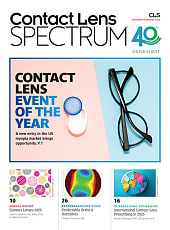The first compression mount frame was made of practically nothing. Could it hold up under normal wear and tear? Several years later, they're still alive and kicking, along with similar innovations and even more to come soon.
In the lab, these bushing mount or compression mount frames have become a favorite. While they can be easy to assemble, removing and mounting the lenses may require the occasional refresher course, from drilling to mounting rimless eyewear.
|
|
|
|
|
|
|
While putting rimless eyewear together can be a snap, the right tools and techniques are key to a successful job. Photos by Alex Yoho |
WHAT'S THE DRILL
Creating a drill mount requires, of course, drilling. There are several technological options for drilling.
Robotic drilling. Most laboratories have a CAM (computer-aided machining) drill—basically, a robotic drill. This is the ultimate way to drill lenses perfectly and consistently every time, but not everyone has enough volume to justify its cost.
Precision lens drills. The next best choice is a precision lens drill that requires some operator input but still keeps the skill factor to a minimum.
For the drilling operation, power drill choices include a flex shaft motor or Dremel motor. Some of these devices use collet-type chucks, so be sure that there is a collet that will fit the drill bit you are using.
Use new, sharp drill bits, especially when drilling polycarbonate, since drilling hot will cause a polycarbonate lens to crack, even after dispensing.
For all types of plastic, run the drill speed fast and travel into the lens slowly.
On some frames you will need to switch drills for various holes.
I would highly recommend that you use a drop of oil in the template hole when using this method.
Hand drills. For the simplest of shops, kits are available from the companies that make compression mount frames that allow you to drill them by hand.
Drilling kits come with a template, a device that has a slightly curved "wing" that is laid or taped to the front of the lens to position the drilling guides properly.
Pay close attention to the instructions for positioning these templates.
Often, a lens pattern with a faint notch on each side is held up to the edged lens, and they are matched up on the sides.
Also, establish a 180 line by using the holes in the pattern. Usually, there is a point on the template at the center that hangs over the lens. Put this point on the mark and make sure that that the "wing" that rests against the front of the lens is aligned carefully with the 180 line.
If drilling a lens by hand, put the drill into a pin-vice and keep turning it until you get through the lens.

If you are replacing lenses, there are two pliers that will help. First, use a pair of flush cutters to remove the back strap. Then, use pulling pliers to pull the frame's prongs out through the front. The bushings will still be around the prongs, so crunch them slightly with a pair of snipe- nosed pliers to facilitate removal.
After you have the lenses drilled or the old bushings removed, prepare the bushings for mounting. In most cases, there are two bushings connected by a strap of plastic.
In nearly all cases, the bushings are pressed through the back side of the lens and must extend through the front of the lens.
Remember: When you press the bushings through from the back, they should absolutely squeak when they are moving through the lens. This ensures that compression of the plastic bushing will occur and is essential to retain the lenses.
Seat the backside of the bushing by lightly grabbing it on the front side of the lens and pulling it firmly. This ensures that the frame is attached to the lens.
Finally, cut the excess bushing even with the front of the lens. There are several ways you can do this. The most dangerous, for obvious reasons, is a razor blade. I prefer to use a pair of flush cutting pliers.
These should be a pair of dedicated cutters that are very sharp and have no relief on the front surface of the cutting edge.
If you can, it's a good idea to polish the face of the cutters. This helps avoid scratching the lens as you cut the bushings.
The one problem with using cutters is that the opening of the bushings is slightly crushed when the bushings are cut. Remedy this by using a pointy object to round the opening—push hard enough to stretch out the front of the hole just a bit to make it easier to start the prong on the endpiece.
|
|
|
|
|
|
FINAL STEPS
When you have opened all the holes, it's time to set the endpiece or bridge piece into position to be compressed into the bushing.
If you've stretched the openings of the bushing a bit, the serrated prongs should stay in place, more or less. Next, use a pair of compression mounting pliers to squeeze the prongs slowly but firmly into the hole of the bushing.
Add a little pressure to the back jaw to keep the bushing from sliding out the back—it will help.
After the prongs are firmly seated, relax the pliers. Then give it another gentle but firm squeeze to make sure. The only thing left to do at this point is to put the frame in universal alignment (see sidebar above).
One more aside: If the mounting loosens up from time to time, it's best to make new lenses and drill the holes smaller.
I dare say you'll only make the error of drilling too big once if it's a 1.67 index photochromic progressive with an anti-reflective treatment!
Address your comments to the author at ayoho@cox.net.





